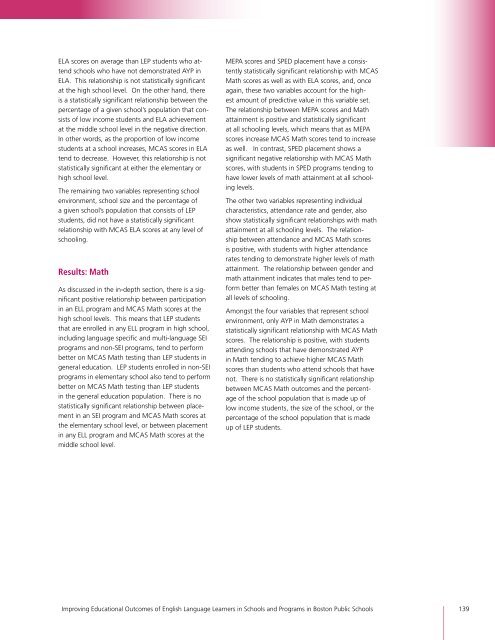Full Report - Center for Collaborative Education
Full Report - Center for Collaborative Education
Full Report - Center for Collaborative Education
Create successful ePaper yourself
Turn your PDF publications into a flip-book with our unique Google optimized e-Paper software.
ELA scores on average than LEP students who attend<br />
schools who have not demonstrated AYP in<br />
ELA. This relationship is not statistically significant<br />
at the high school level. On the other hand, there<br />
is a statistically significant relationship between the<br />
percentage of a given school’s population that consists<br />
of low income students and ELA achievement<br />
at the middle school level in the negative direction.<br />
In other words, as the proportion of low income<br />
students at a school increases, MCAS scores in ELA<br />
tend to decrease. However, this relationship is not<br />
statistically significant at either the elementary or<br />
high school level.<br />
The remaining two variables representing school<br />
environment, school size and the percentage of<br />
a given school’s population that consists of LEP<br />
students, did not have a statistically significant<br />
relationship with MCAS ELA scores at any level of<br />
schooling.<br />
Results: Math<br />
As discussed in the in-depth section, there is a significant<br />
positive relationship between participation<br />
in an ELL program and MCAS Math scores at the<br />
high school levels. This means that LEP students<br />
that are enrolled in any ELL program in high school,<br />
including language specific and multi-language SEI<br />
programs and non-SEI programs, tend to per<strong>for</strong>m<br />
better on MCAS Math testing than LEP students in<br />
general education. LEP students enrolled in non-SEI<br />
programs in elementary school also tend to per<strong>for</strong>m<br />
better on MCAS Math testing than LEP students<br />
in the general education population. There is no<br />
statistically significant relationship between placement<br />
in an SEI program and MCAS Math scores at<br />
the elementary school level, or between placement<br />
in any ELL program and MCAS Math scores at the<br />
middle school level.<br />
MEPA scores and SPED placement have a consistently<br />
statistically significant relationship with MCAS<br />
Math scores as well as with ELA scores, and, once<br />
again, these two variables account <strong>for</strong> the highest<br />
amount of predictive value in this variable set.<br />
The relationship between MEPA scores and Math<br />
attainment is positive and statistically significant<br />
at all schooling levels, which means that as MEPA<br />
scores increase MCAS Math scores tend to increase<br />
as well. In contrast, SPED placement shows a<br />
significant negative relationship with MCAS Math<br />
scores, with students in SPED programs tending to<br />
have lower levels of math attainment at all schooling<br />
levels.<br />
The other two variables representing individual<br />
characteristics, attendance rate and gender, also<br />
show statistically significant relationships with math<br />
attainment at all schooling levels. The relationship<br />
between attendance and MCAS Math scores<br />
is positive, with students with higher attendance<br />
rates tending to demonstrate higher levels of math<br />
attainment. The relationship between gender and<br />
math attainment indicates that males tend to per<strong>for</strong>m<br />
better than females on MCAS Math testing at<br />
all levels of schooling.<br />
Amongst the four variables that represent school<br />
environment, only AYP in Math demonstrates a<br />
statistically significant relationship with MCAS Math<br />
scores. The relationship is positive, with students<br />
attending schools that have demonstrated AYP<br />
in Math tending to achieve higher MCAS Math<br />
scores than students who attend schools that have<br />
not. There is no statistically significant relationship<br />
between MCAS Math outcomes and the percentage<br />
of the school population that is made up of<br />
low income students, the size of the school, or the<br />
percentage of the school population that is made<br />
up of LEP students.<br />
Improving <strong>Education</strong>al Outcomes of English Language Learners in Schools and Programs in Boston Public Schools 139


